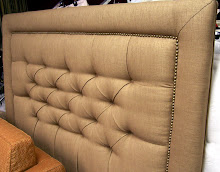
These beautiful Empire era pieces were in desperate need of careful restoration and it was very important that any repair work be undertaken with the greatest thought and knowledge of historically accurate methods and techniques.

 Once stripped, it became apparent that a previous upholsterer had altered the frame and harmed the structural integrity of the sofa.
Once stripped, it became apparent that a previous upholsterer had altered the frame and harmed the structural integrity of the sofa.The antique sofa from the Shirley Eustis House was originally constructed with three evenly spaced hardwood bars from side to side. These “stretchers” fastened the front of the frame to the back, providing stability and strength to the frame (see red arrows on Figure A). Next webbing was applied on top of the frame from front to back and woven through side to side. The next step was to cover the webbing with a layer of horsehair topped with a layer of cotton for padding and covered with fabric, creating the decking for a cushion. (See Figure B) Next a loose cushion was placed on top of the decking.
At some point in the past the sofa was reupholstered. Whoever performed the work cut the stretchers out, added wood to the underside of the frame (see green arrows on Figure A) to which was covered with webbing. Springs were used to form a fully upholstered seat, eliminating the cushion. This frame was not designed to handle springs, and the jerry-rigged method by which it was altered left the frame weak and subject to damage, which is exactly what happened.

Walter, in consultation with furniture historian Edward S. Cooke, Jr., editor of Upholstery in America & Europe from the Seventeenth Century to World War I, (Norton, 1987) came up with the recommended repair work on this beautiful piece.

 Stretchers were once again built into the seat and new wood was applied to the sides and back for structural integrity.
Stretchers were once again built into the seat and new wood was applied to the sides and back for structural integrity.

 A new cushion is made, also using cotton padding and horsehair.
A new cushion is made, also using cotton padding and horsehair.



We want to thank the Shirley-Eustis House for entrusting us with the repair of these beautiful pieces of furniture - and history.










